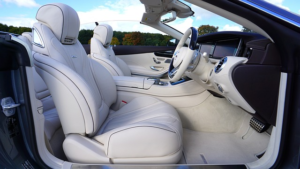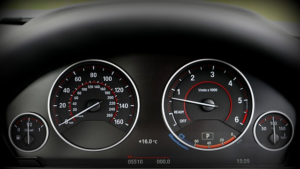3 1st-Time NASCAR Wins That Definitely Don’t Need An Asterisk – Frontstretch.com
Chris Buescher’s second career win came last Saturday night (Sept. 17) at Bristol Motor Speedway, a convincing win as Buescher led 169 laps, more than any other driver, and used what turned out to be a brilliant two-tire strategy on his final pit stop to beat runner-up Chase Elliott to the finish by a healthy .458 seconds.
Buescher did just about everything right, working lapped tr…….

Chris Buescher’s second career win came last Saturday night (Sept. 17) at Bristol Motor Speedway, a convincing win as Buescher led 169 laps, more than any other driver, and used what turned out to be a brilliant two-tire strategy on his final pit stop to beat runner-up Chase Elliott to the finish by a healthy .458 seconds.
Buescher did just about everything right, working lapped traffic to his advantage in the closing laps to ultimately seal the deal. The former NASCAR Xfinity Series champion and his team celebrated a win that came over 200 races after his first, just shy of a Cup Series record for races between wins.
But to some fans, it might as well have been Buescher’s first win. That’s because his actual first win, which came at Pocono Raceway in 2016, deserves an asterisk, they say.
But does it?
If there’s anything race fans hate, it’s a win tainted by weather. Many will say it’s not worth as much as a win in which the driver went the full distance to claim the top spot. Oh, unless he went the whole distance to claim the top spot but won because his team made a fuel mileage call. Then that doesn’t count either. First wins get extra bonus scrutiny, too.
Which is absolutely ridiculous.
NASCAR doesn’t put an asterisk in the record books next to a win in a weather-shortened race or a win based on fuel mileage. Why? Because they’re wins, period.
Let’s take a peek at three first wins, spanning the last 15 years or so, that some fans have scoffed at because of the circumstances: the 2007 Coca-Cola 600, the 2016 Pennsylvania 400 and the 2021 Yellawood 500 and the strategies the winning teams employed, as all are different, and the circumstances of each driver’s race and season.
2007 Coca-Cola 600, Charlotte Motor Speedway
The lowdown
Race winner: Casey Mears
Margin of victory: 9.561 seconds
Led: once for six laps
The Coca-Cola 600 is the Cup Series’ longest race, and it’s not unusual for it to come down to mileage, depending on how cautions fall. What makes this race a little unusual is that the mileage game played into the hands of not just Mears, but four others as well, all bigger underdogs than the No. 25.
Charlotte has always had a reputation for being extremely temperature-sensitive, and especially in the 600 as the race starts in daylight and ends well after the sun goes down. The race saw a total of 29 lead changes among 15 drivers.
The dominant car in the early going was the No. 2 of Kurt Busch, who led twice for 107 laps, the most of the race, but Busch crashed out after 296 laps. Reigning champ Jimmie Johnson made a run up front and was in position to challenge late, but Tony Stewart took over the lead on lap 338 in the No. 20 for Joe Gibbs Racing. With 25 to go, Stewart held point over Mears, Dale Earnhardt Jr., Johnson and Denny Hamlin. The final caution of the night had come on lap 338 and the restart came on lap 241, with 59 laps remaining. That was a very long fuel run at Charlotte at the time, but another caution wasn’t unexpected, so teams figured things would go their way.
At that point, with 25 to go, Stewart had a comfortable lead, but reports from his pit were troubling; he’d need to pit if the yellow flag didn’t fly. Still, without a caution, the other teams were in the same boat. Stewart and Co. hoped they could build a comfortable enough lead to cycle through pit stops on top. Which they did. It’s just that five others didn’t pit.
It wasn’t that a slow car stole a race. Mears had been fast enough to run with the leaders and was inside the top 10 for much of the race. Usually a fast car is at a disadvantage in the mileage game.
What put Mears at an advantage besides the speed of his car that night was crew chief Darian Grubb, who has not only won with every driver he’s called races for but was a master at calculating fuel mileage down to the last drop. His razor’s-edge calculations also gave Hamlin some wins later on.
As the laps clicked down, Mears backed out of the throttle a little, sacrificing a couple of spots. A few others backed out a little as well. It would be just enough.
Mears assumed the lead with six laps to go when Hamlin gave up the ghost to pit for fuel, and had the added advantage of clean air to easily take the win over Stewart’s JGR teammate, JJ Yeley. Kyle Petty, Reed Sorenson and Brian Vickers rounded out the top five with Stewart finishing sixth.
How close was it? Mears ran out of fuel on the cool-down lap.
It’s a bit nerve-wracking to watch a mileage race and it has to be worse to drive one. FOX broadcaster Darrell Waltrip commented on the trust between Stewart and crew chief Greg Zipadelli late in the race, and ultimately it was trust in Grubb’s calculation that won the race.
Interestingly, all five of the cars that stayed out were running in the top 15 before the other drivers pitted, so they weren’t simply slow cars taking advantage of the faster ones burning through more fuel. That’s more of a myth anyway, because the backmarker cars are generally going as hard as they can and burning through their own supply. You don’t see a lot of under-funded underdogs pulling off fuel wins; most of this top five were running for well-funded organizations.
2016 Pennsylvania 400, Pocono Raceway
The lowdown
Race winner: Chris Buescher
Margin of victory: under caution
Led: once for 12 laps
Kyle Larson held the lead with just under 40 laps to go in what had been a fairly racy day at Pocono. Rain had been in the area and the day was becoming increasingly dismal, with fog rolling in and rain still not out of the question after the race had already been postponed to Monday thanks to Mother Nature.
It looked as though it was going to hold off until the scheduled 160 laps concluded, though, so Larson pitted with 36 laps to go, and handed the lead to Austin Dillon. As pit stops continued, Buescher, then racing the No. 38 for underfunded Front Row Motorsports, inherited the race lead. It was the first time Buescher, then the reigning Xfinity Series champ, had led a Cup Series race.
Buescher was under contract with Roush Fenway Racing and had been farmed out to FRM when RFR didn’t have a seat for the 23-year-old. RFR wanted to keep Buescher, a driver they thought could win races for them, and so worked with FRM and the driver to give him a full-time, though badly underfunded, Cup ride.
On that Monday at Pocono, the fog that had been slowly rolling in descended like a blanket suddenly, leaving the drivers on track warning their teams that visibility was next to nothing. Fans in the stands couldn’t see the race. Spotters couldn’t see their cars. Hoping the caution was coming, rookie Buescher stayed on track under the direction of veteran crew chief Bob Osborne. It gave Buescher a bonus point for leading and put the team in decent position for when the fog lifted and the race resumed.
Only the fog didn’t lift. After an hour-and-a-half with no signs of improvement, NASCAR called the race. Chris Buescher was a Cup winner.
Buescher’s best 2016 finish before the Pennsylvania 400 was 14th the previous week at Indianapolis Motor Speedway, only his second top 20 of the season so far.
So, it’s true that Buescher wasn’t going to win that day at Pocono because he didn’t have a car capable of winning. Fair enough.
But here’s the thing. Weather had been threatening. Any team could have made the call to try and wait it out. On lap 120, four laps before Larson pitted from the lead, Buescher was running 21st. Ten laps later, he assumed the lead. That means 20 drivers and crew chiefs made the call to pit and hope the race went the distance. Had any of them stayed out a few more laps, they’d have beaten Buescher handily.
Sometimes in racing it’s better to be lucky than good. And to make the call that nobody else does.
2021 YellaWood 500, Talladega Superspeedway
The lowdown
Race winner: Bubba Wallace
Margin of victory: under caution
Led: once for five laps
Like Buescher’s maiden win, Wallace’s came when bad weather came calling. But unlike Buescher, who won because his team worked a different strategy, Wallace was the race leader when the rain came.
Wallace is a very strong superspeedway driver, and he’s had strong finishes as both Daytona and Talladega in the past. It should not have surprised anyone that he was in the mix.
The race didn’t feature a dominant driver; 19 different drivers led laps and none more than 16, the most on the day led by Kevin Harvick.
Superspeedway strategy often frustrates fans. Because finishing is the main objective and crashes are so common and wipe out so many cars, the middle part of races is often fairly tame as drivers set themselves up for a closing run. Even the stage finishes are more about saving the cars for later. Tension increases dramatically as the race winds down and drivers start jockeying for the win.
But on that particular day, with rain forging ever closer, intensity picked up early late in stage two. Drivers knew the race would likely end because of the radar picture and the hour — Talladega doesn’t have lights and the race was official already.
Wallace picked his way to the front, using the racing lanes to his advantage, and once he took over the top spot, wresting it from Kurt Busch, as reports of raindrops increased, he worked the track to hold off charges from veterans Brad Keselowski, Busch and Joey Logano. A crash deeper in the pack coincided with the first raindrops.
There was no time for pit gambles; the race was red-flagged immediately as the skies opened and Wallace was named the winner as the race leader at the time of caution.
It’s really hard to argue wins like that because the driver who was leading at the end won the race. Had the race been at Daytona, it might have restarted under the lights, but racing after dark wasn’t an option.
Not one of these drivers didn’t deserve his first win. There’s a reason NASCAR’s record books aren’t riddled with asterisks for all kinds of crazy reasons: NASCAR recognizes a race win as a race won by that driver, full stop. A crew chief who can calculate mileage so closely and know his driver so well (and convince that driver to back out at a time when adrenaline is coursing through him) that they can cross the finish line seconds before the tank runs dry is part of the game and an asset to a team.
So is one who can wait out a pit cycle with an eye on impending weather. If he makes a decision that every other crew chief could have made and didn’t, that’s a winning decision.
And if a driver is leading a race when it ends, even if it ends early because of weather, he crossed the finish line first.
There are no lesser wins in NASCAR. Take a closer look at what went into every race and every win. If it was a legal, clean win, it’s as good as any other. And in a sport where roughly 90% of drivers throughout its history have never won a race, it’s quite an accomplishment. A win is a win is a win.
Sign up for the Frontstretch Newsletter
A daily email update (Monday through Friday) providing racing news, commentary, features, and information from Frontstretch.com
We hate spam. Your email address will not be sold or shared with anyone else.






